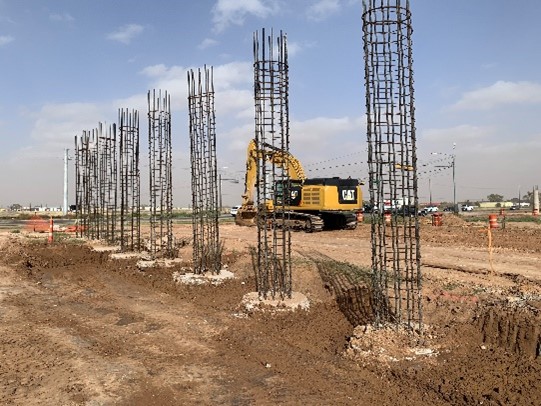Specialized Geotechnical Works for Lasting Building And Construction Solutions
Specialized Geotechnical Works for Lasting Building And Construction Solutions
Blog Article
How Consulting Engineers Enhance Geotechnical Design Projects: Insights Into Their Experience, Methodologies, and Collaborative Approaches
Consulting engineers are critical in enhancing geotechnical engineering jobs, using their specialized knowledge to navigate the complexities of subsurface conditions. Their methodologies include a series of site examination strategies, consisting of Criterion Infiltration Examinations (SPT) and Cone Penetration Examinations (CPT), which notify vital choices during the style and building phases. Their collaborative approaches foster interaction among diverse job stakeholders, inevitably shaping the task's trajectory. As we analyze the complex functions these experts play, it ends up being clear that their payments extend beyond technical competence, triggering a more detailed check out the effects for project success.
Role of Consulting Engineers
The proficiency of speaking with engineers in geotechnical engineering is essential to the effective execution of building and construction projects. These specialists play a crucial function in evaluating dirt and rock residential or commercial properties, which are important aspects influencing layout and construction decisions. By conducting thorough site investigations, speaking with designers accumulate necessary data that notifies the style process, guaranteeing jobs are improved steady and ideal ground.
Consulting engineers also offer very useful insights into danger management (geotechnical geologist). They identify prospective geotechnical dangers, such as landslides, soil liquefaction, and settlement problems, allowing stakeholders to apply efficient mitigation approaches. Their competence aids in enhancing structure layouts, which can bring about substantial cost financial savings and enhanced safety
Moreover, speaking with engineers function as a vital link between job proprietors, engineers, and contractors. Their ability to convert complex geotechnical data into actionable recommendations fosters partnership and promotes educated decision-making throughout the job lifecycle. This multidisciplinary approach not only enhances job effectiveness however likewise makes certain compliance with governing criteria and ideal practices.
Trick Methodologies in Geotechnical Engineering

One primary method is website examination, which involves conducting field tests and lab evaluations to collect information on subsurface problems. Strategies such as Standard Penetration Testing (SPT) and Cone Infiltration Screening (CPT) are extensively used to evaluate soil stratigraphy and strength. Additionally, geophysical methods, consisting of seismic and electric resistivity studies, give non-invasive methods to analyze subsurface features.
An additional important technique is numerical modeling, which enables engineers to mimic numerous circumstances and anticipate just how soil-structure communications will certainly behave under different loading conditions. Finite Component Evaluation (FEA) is a typical technique utilized in this context.
Additionally, the style of foundations, keeping structures, and earthworks counts greatly on these approaches - geotechnical geologist. By integrating sophisticated analytical devices with area data, speaking with engineers can create customized options that attend to particular task obstacles, eventually adding to the security and security of building projects
Relevance of Soil Evaluation
Dirt analysis functions as a foundational component in geotechnical engineering, giving vital understandings into the physical and chemical homes of dirt required for reliable construction preparation. Understanding soil features is vital for determining its load-bearing capability, water drainage behavior, and capacity for negotiation or instability. Detailed dirt investigations, including sampling and research laboratory testing, assistance determine criteria such as dirt type, wetness web content, thickness, and shear stamina.
These analyses inform the choice of ideal construction methods and products, inevitably influencing task security and long life. Natural soils may need various structure styles contrasted to granular dirts, demanding customized design solutions. Soil analysis aids in recognizing impurities that can posture risks to human health and wellness or the atmosphere, allowing for the development of reduction approaches.
Including dirt evaluation right into the very early phases of job development helps to minimize unforeseen challenges, making sure that engineers can anticipate and resolve possible problems before they rise. By developing an extensive understanding of the site problems, seeking advice from engineers can optimize layout effectiveness and reduce prices, consequently improving the overall success of geotechnical design projects.
Joint Techniques in Tasks
Successful geotechnical projects usually depend upon collaborative strategies that unite diverse know-how from different disciplines. Reliable collaboration amongst speaking with wikipedia reference designers, geologists, environmental researchers, and building professionals is vital for addressing complicated challenges and enhancing job outcomes. special info By leveraging the special abilities and understanding of each group member, jobs can take advantage of an all natural understanding of the site problems, governing demands, and design constraints.
Routine interaction and interdisciplinary conferences facilitate the sharing of insights and cultivate a culture of team effort. These joint initiatives enable the recognition of prospective threats early in the task lifecycle, permitting timely reduction approaches. Furthermore, incorporating comments from stakeholders, consisting of neighborhood communities and regulative companies, makes sure that all perspectives are taken into consideration, enhancing project acceptance and conformity.
In addition, the integration of sophisticated innovations, such as Geographic Info Solution (GIS) and Structure Info Modeling (BIM), additional improves collaboration. These tools enable the real-time sharing of data and visualization of geotechnical conditions, promoting informed decision-making. Ultimately, a collaborative approach not only improves project execution yet additionally lays the structure for ingenious options find more info to intricate geotechnical design difficulties.
Influence On Project Outcomes

Consulting engineers use advanced methods such as risk evaluation and anticipating modeling, which enhance the precision of project forecasts. Their capability to incorporate ingenious technologies, like geotechnical instrumentation and data analytics, better improves the style and building and construction processes. As an outcome, jobs experience improved effectiveness, reduced expenses, and minimized delays.
In addition, fostering efficient interaction and collaboration among team members improves analytical capacities. When challenges arise, an unified front permits for speedy identification of services, stopping possible setbacks. Inevitably, the joint initiatives of seeking advice from designers add to greater quality outcomes, guaranteeing that jobs fulfill both governing criteria and customer assumptions.
Verdict

Report this page